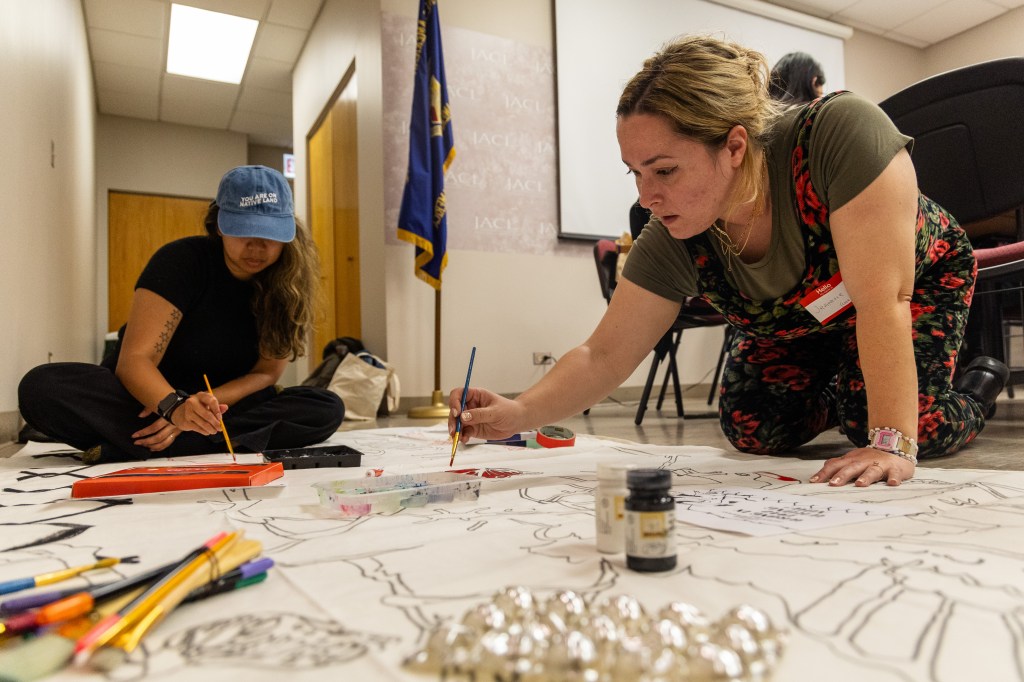As the federal immigration crackdown in Chicago grows increasingly aggressive, Rebecca Ozaki sees disturbing parallels to her own family’s detention in Japanese American incarceration camps during World War II.
Within a month after the bombing of Pearl Harbor, FBI agents came to her teenaged grandfather’s home in California and began questioning the entire household. His father was taken away, first to the Los Angeles County jail and then to a Department of Justice camp in New Mexico, where he became one of more than 120,000 Japanese Americans estimated to have been unjustly incarcerated around the country during that time.
Now Ozaki fears history is repeating itself as turbulent immigration raids, mass detentions and a climate of fear plague much of the Chicago area.
“This administration is using similar policies, which is really terrifying, that (were) used against my family and people of Japanese ancestry in 1942,” said Ozaki, program director of the Chicago chapter of the Japanese American Citizens League. “Children are witnessing their parents get taken, just like my grandfather saw his dad get taken.”
With this ancestral trauma in mind, Ozaki will be protesting the Trump administration at the “No Kings/Hands Off Chicago” march and rally starting at noon on Saturday in Grant Park, one of roughly 2,500 similar demonstrations that will be held across the country and around the world.
The “No Kings” event at Grant Park is hosted by multiple organizations, including Equality Illinois, Indivisible Chicago, Chicago Federation of Labor, Personal PAC, Sierra Club Illinois and the American Civil Liberties Union of Illinois. Dozens of other “No Kings” rallies and marches are also scheduled at suburban locations throughout the Chicago area, including Naperville, Elgin, Highland Park, Aurora and Gary.
Demonstrators march for the “No Kings” rally in the Loop on June 14, 2025. (John J. Kim/Chicago Tribune)
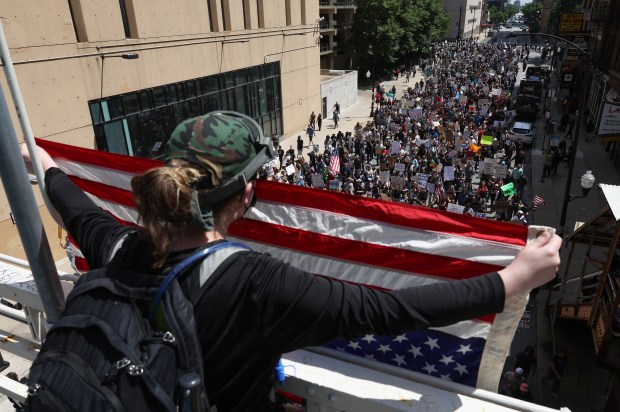
A demonstrator holds a U.S. flag from a CTA “L” platform as fellow demonstrators march for the “No Kings” rally in the Loop on June 14, 2025. (John J. Kim/Chicago Tribune)
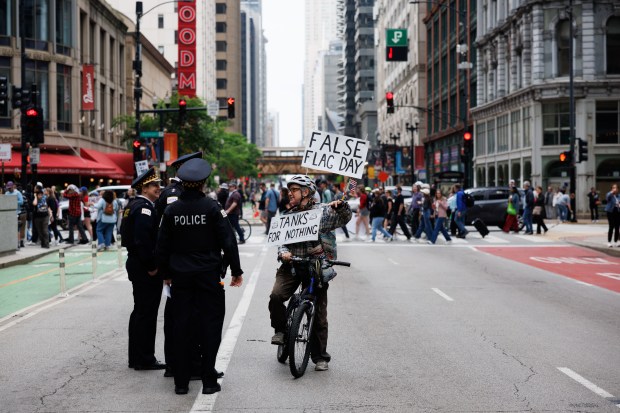
Thousands of people attend a “No Kings” rally in the Loop on June 14, 2025. (Armando L. Sanchez/Chicago Tribune)
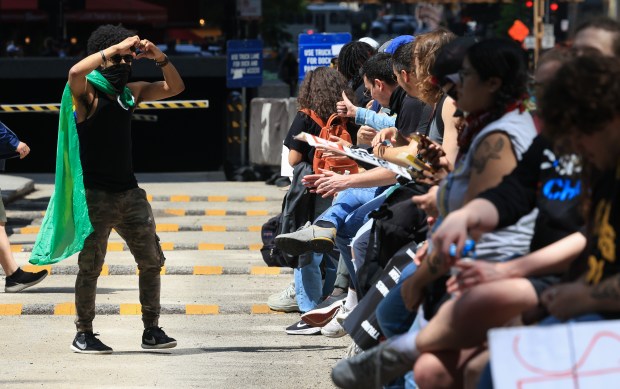
A demonstrator makes a heart gesture to fellow demonstrator at the conclusion of a march for the “No Kings” rally at Daley Plaza on June 14, 2025. (John J. Kim/Chicago Tribune)
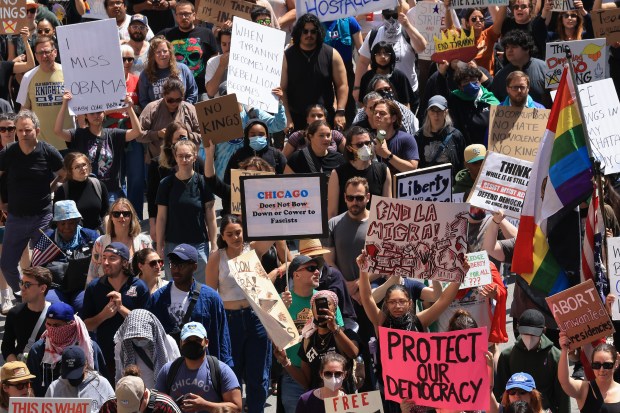
Demonstrators march for the “No Kings” rally in the Loop on June 14, 2025. (John J. Kim/Chicago Tribune)
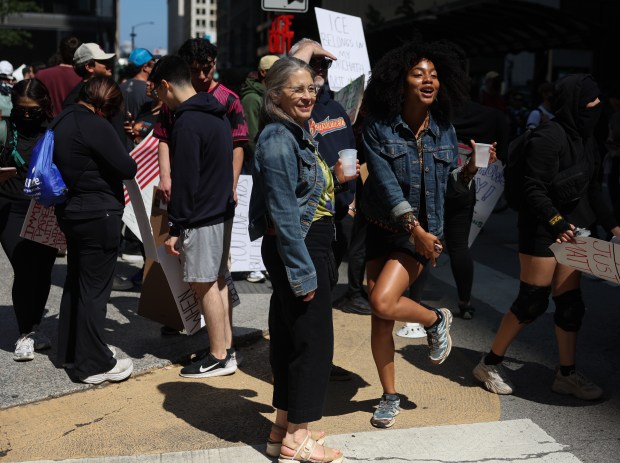
Talha Barberousse, right, dances to hip hop music at the conclusion of a march for the “No Kings” rally at Daley Plaza on June 14, 2025. (John J. Kim/Chicago Tribune)
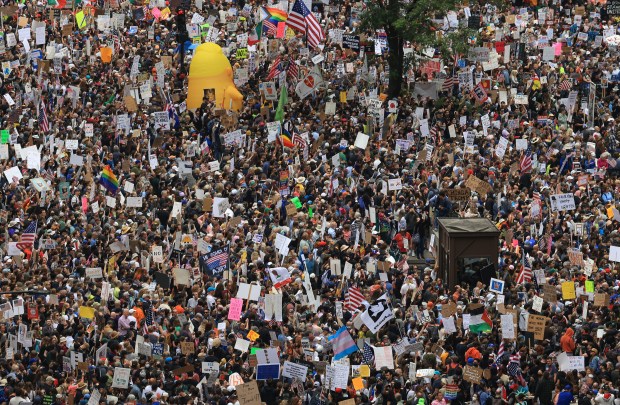
Tens of thousands of demonstrators spill onto Dearborn Street to attend the “No Kings” rally at Daley Plaza on June 14, 2025. (John J. Kim/Chicago Tribune)
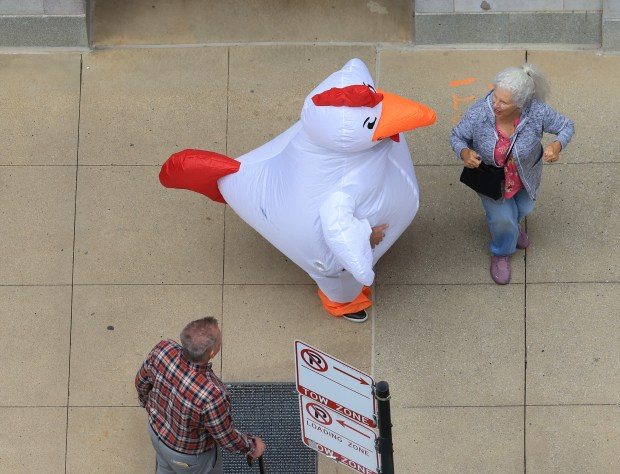
A demonstrator dressed in an inflatable chicken costume greets a woman during the “No Kings” rally at Daley Plaza on June 14, 2025, in Chicago. (John J. Kim/Chicago Tribune)
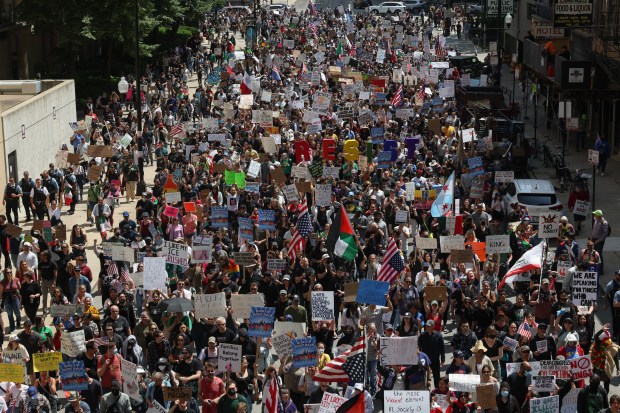
Demonstrators march for the “No Kings” rally in the Loop Saturday, June 14, 2025, in Chicago. (John J. Kim/Chicago Tribune)
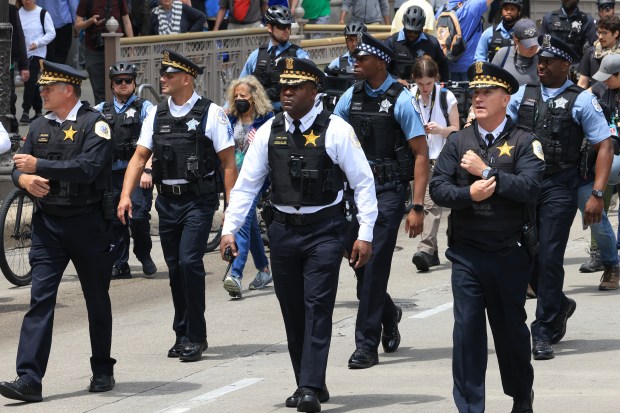
Chicago police Supt. Larry Snelling, center, and police supervisors walk ahead marchers of the “No Kings” rally in the Loop on June 14, 2025. (John J. Kim/Chicago Tribune)
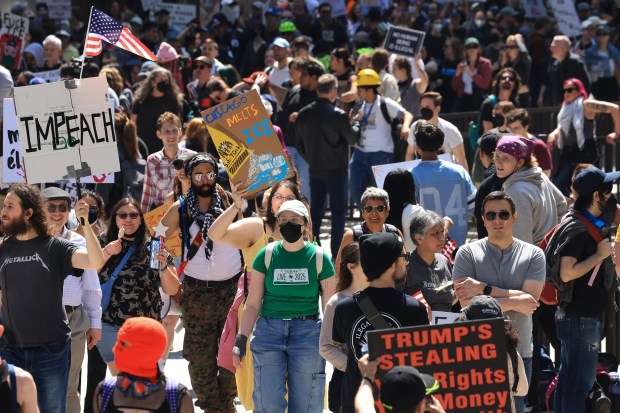
Demonstrators reach Daley Plaza at the conclusion of a march for the “No Kings” rally in the Loop on June 14, 2025. (John J. Kim/Chicago Tribune)
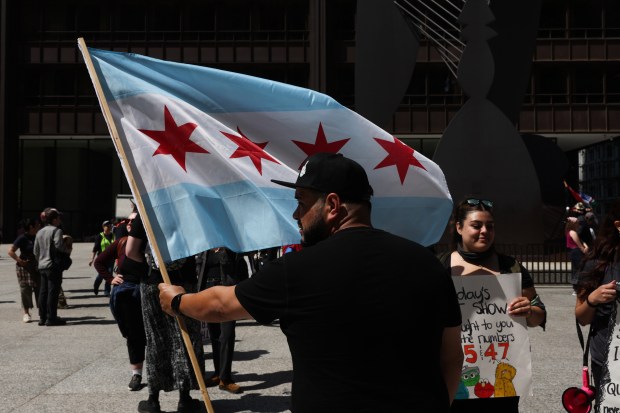
José Ramírez holds a Chicago flag at the conclusion of a march for the “No Kings” rally at Daley Plaza on June 14, 2025. (John J. Kim/Chicago Tribune)
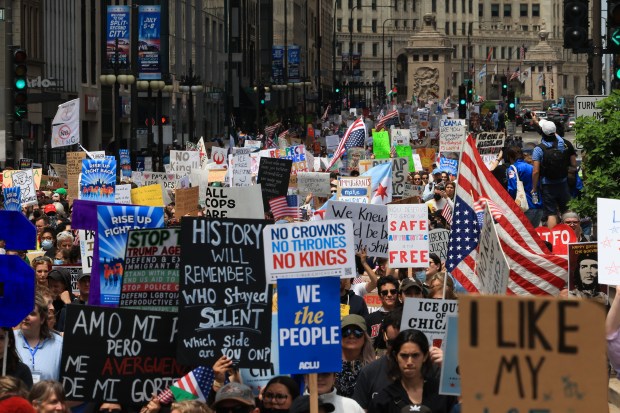
Demonstrators march for the “No Kings” rally in the Loop on June 14, 2025. (John J. Kim/Chicago Tribune)
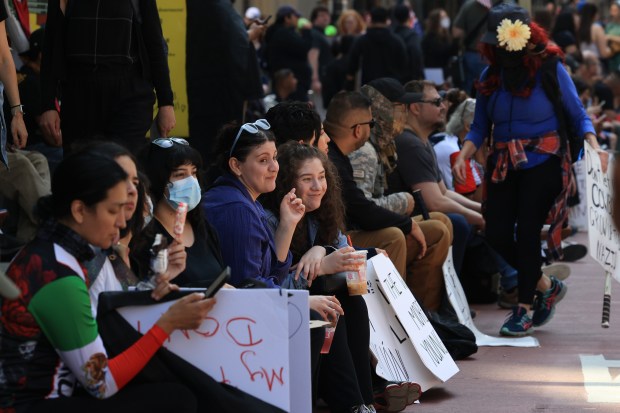
Demonstrators rest on a CTA bus platform curb at the conclusion of a march for the “No Kings” rally at Daley Plaza on June 14, 2025. (John J. Kim/Chicago Tribune)
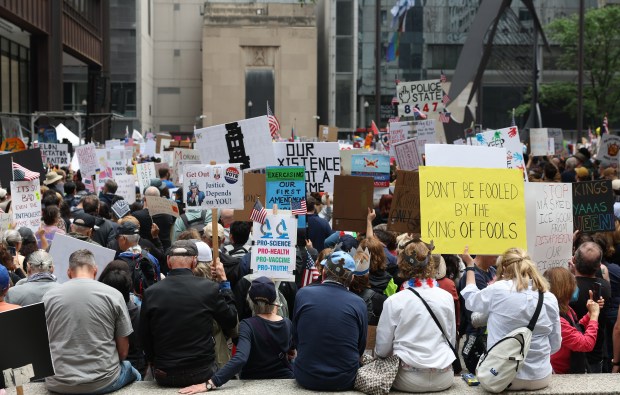
Thousands of demonstrators fill Daley Plaza for a “No Kings” rally on June 14, 2025. (John J. Kim/Chicago Tribune)
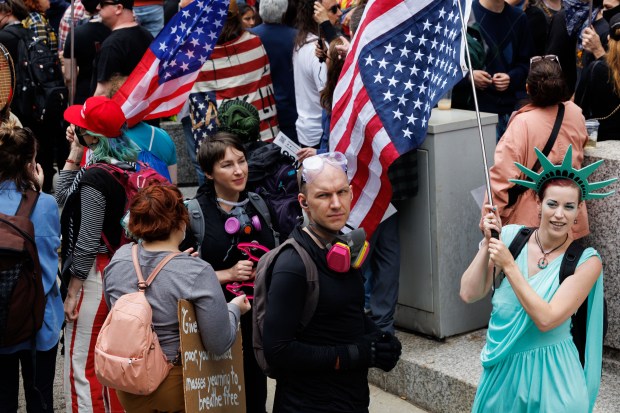
Thousands of people attend a “No Kings” protest in the Loop on June 14, 2025. (Armando L. Sanchez/Chicago Tribune)
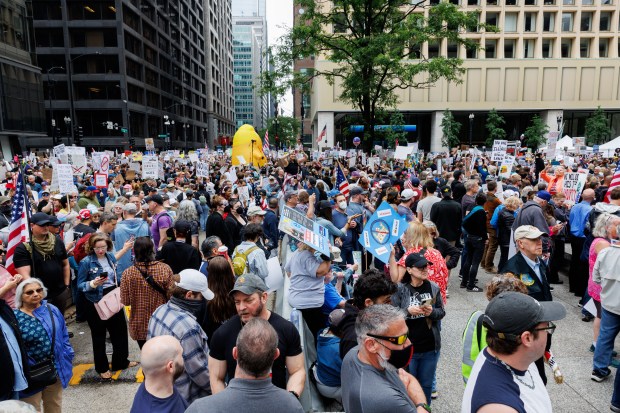
Thousands of people attend a “No Kings” rally in the Loop on June 14, 2025. (Armando L. Sanchez/Chicago Tribune)
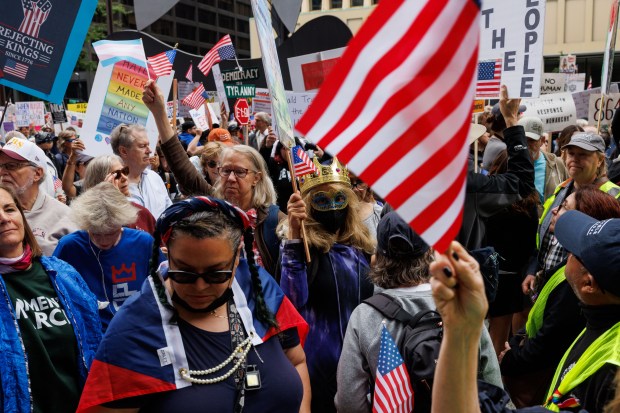
Thousands of people attend a “No Kings” rally in the Loop on June 14, 2025. The rally started around noon in Daley Plaza. (Armando L. Sanchez/Chicago Tribune)
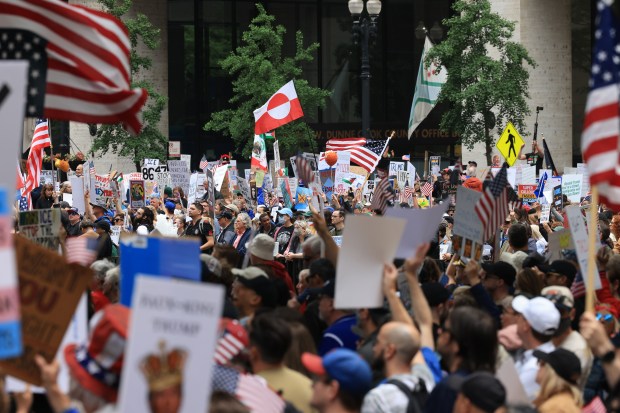
Thousands of demonstrators fill Daley Plaza for a “No Kings protest on June 14, 2025. (John J. Kim/Chicago Tribune)
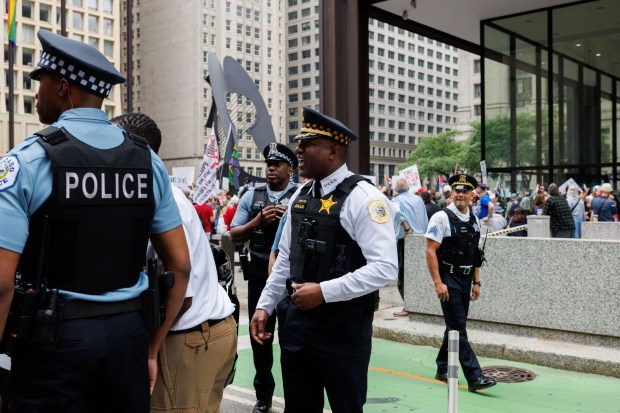
Chicago police Superintendent Larry Snelling and other officers walk around, as thousands of people attend a “No Kings” rally in the Loop on June 14, 2025. (Armando L. Sanchez/Chicago Tribune)
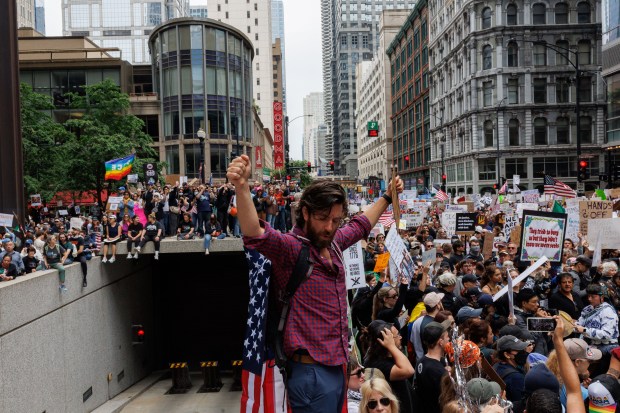
Thousands of people attend a “No Kings” rally in the Loop on June 14, 2025. The rally started around noon in Daley Plaza. (Armando L. Sanchez/Chicago Tribune)
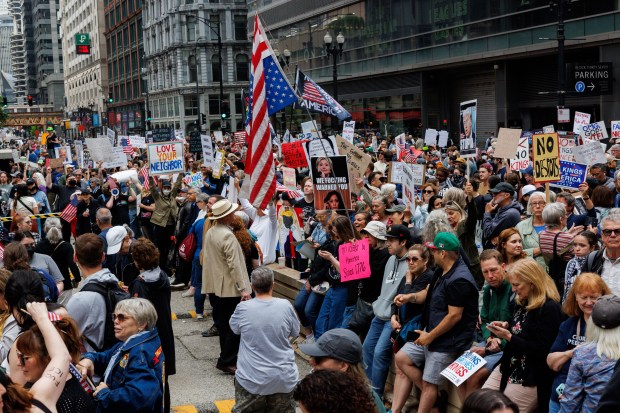
Thousands of people attend a “No Kings” rally in the Loop on June 14, 2025. The rally started around noon in Daley Plaza. (Armando L. Sanchez/Chicago Tribune)
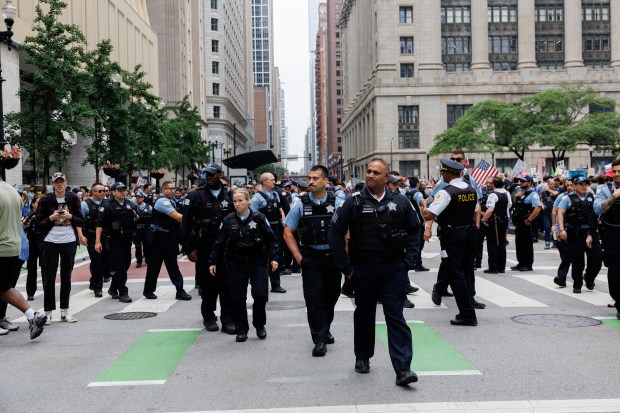
Police walk through a crowd while thousands of people attend a “No Kings” rally in the Loop on June 14, 2025. (Armando L. Sanchez/Chicago Tribune)
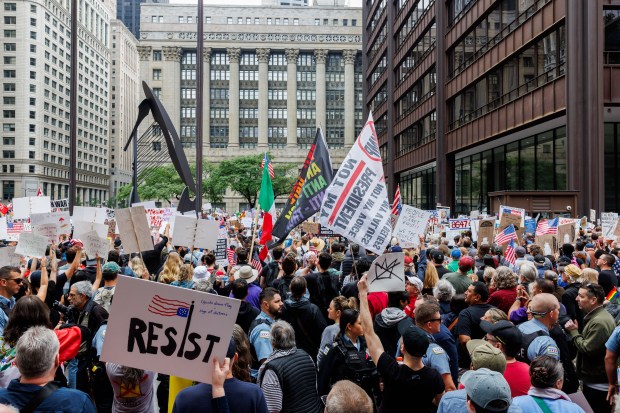
Thousands of people attend a “No Kings” rally in the Loop on June 14, 2025. (Armando L. Sanchez/Chicago Tribune)
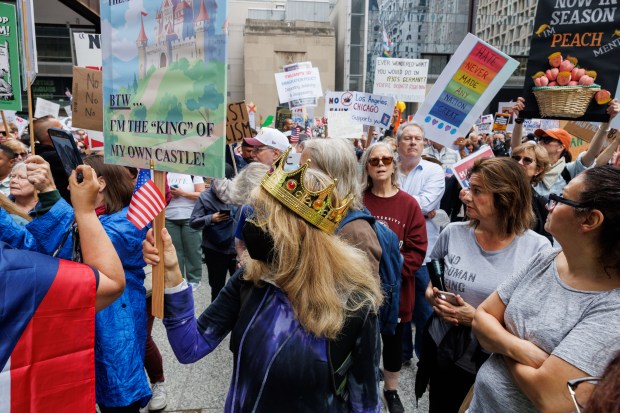
Thousands of people attend a “No Kings” rally in the Loop on June 14, 2025. (Armando L. Sanchez/Chicago Tribune)
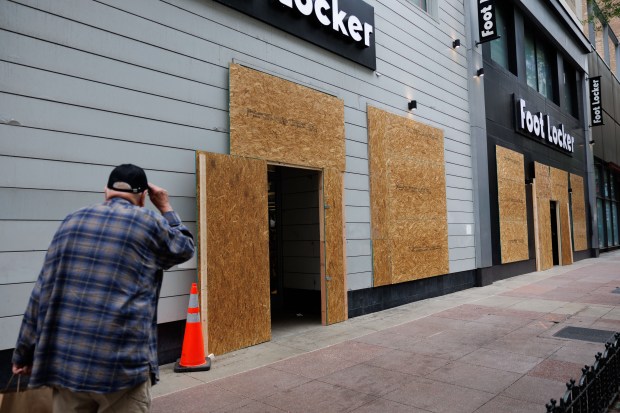
Several businesses sit boarded up before a “No Kings” rally in the Loop on June 14, 2025. The rally started around noon in Daley Plaza. (Armando L. Sanchez/Chicago Tribune)
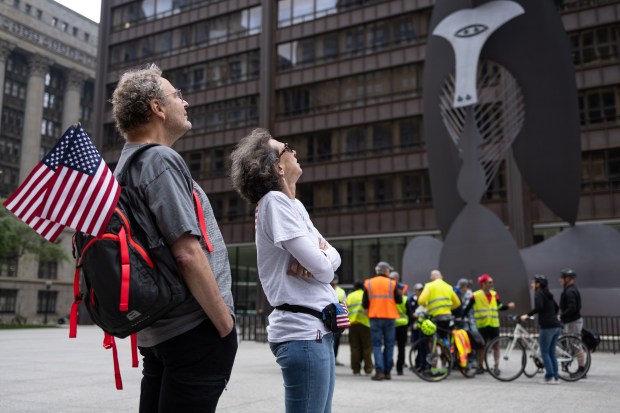
Steve Philoon, left, and his wife, Sara Kurensky, look up at the flags in Daley Plaza ahead of the “No Kings” protest downtown on June 14, 2025. Philoon and Kurensky were helping organizers set up for the event. “It’s weightier than I think anything we’ve done,” Kurensky said. “There’s just a heaviness now. It’s time to reclaim our flag.” (Audrey Richardson/Chicago Tribune)
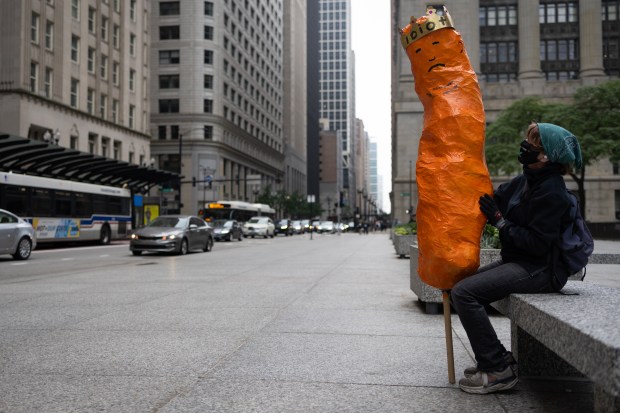
Eren W. sits with her handmade Donald Trump Cheeto hours prior to the “No Kings” protest in Daley Plaza on June 14, 2025. “I wanted to make a TACO this time, but I ran out of chicken wire,” she said. (Audrey Richardson/Chicago Tribune)
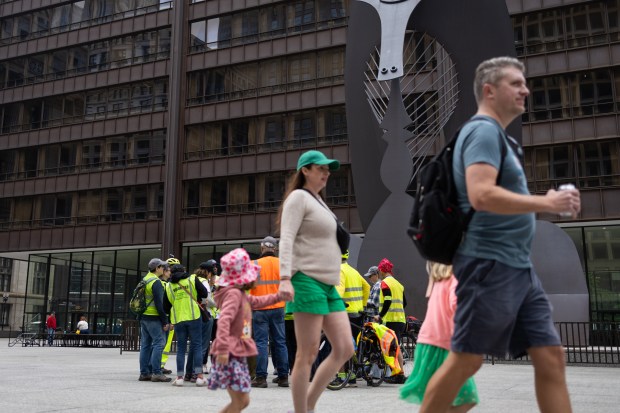
People walk past as volunteers prepare hours prior to the “No Kings” protest in Daley Plaza on June 14, 2025. (Audrey Richardson/Chicago Tribune)
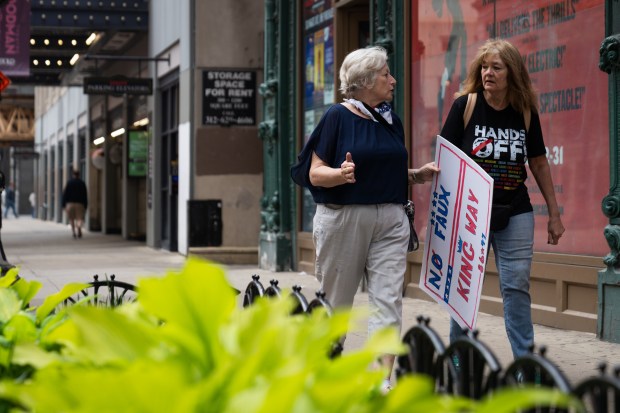
Marie Mindeman, left, and Diane Jacobson walk towards Daley Plaza hours prior to the “No Kings” protest in downtown Chicago on June 14, 2025. They took the train downtown early, to get ahead of the crowds and get a cocktail, they said. (Audrey Richardson/Chicago Tribune)
Show Caption
1 of 30
Demonstrators march for the “No Kings” rally in the Loop on June 14, 2025. (John J. Kim/Chicago Tribune)
The first “No Kings” protests in June drew millions of demonstrators nationwide, with throngs of marchers crowding the downtown Chicago event.
Local organizers believe the upcoming protests will be even bigger in scale and fervor, fueled by anger at President Donald Trump’s recent immigration enforcement blitz and bid to federalize National Guard troops, with Chicago a prime target of both attempts to augment federal power.
“Nationally, we expect this will be the largest mass mobilization that maybe we’ve ever seen across the country,” said Kathy Tholin, board member of Indivisible Chicago Alliance and a Chicago event co-organizer. “So many Chicagoans want to speak out. The federal invasion of Chicago — either currently on the streets or threatened by the Trump administration — I think it’s making Chicagoans want to say this is not acceptable and show that. So we do expect a good crowd on Saturday.”
Tholin said the Grant Park demonstration will have a prominent role in the larger protest movement, as the Chicago area serves as ground zero for ongoing ramped-up immigration enforcement — as well as local resistance to those operations and the broader Trump administration agenda.
“The eyes of the country are on what we do here in Chicago,” she added. “People are watching to see how Chicagoans respond to what has been happening … Because we are under attack so dramatically. So violently.”
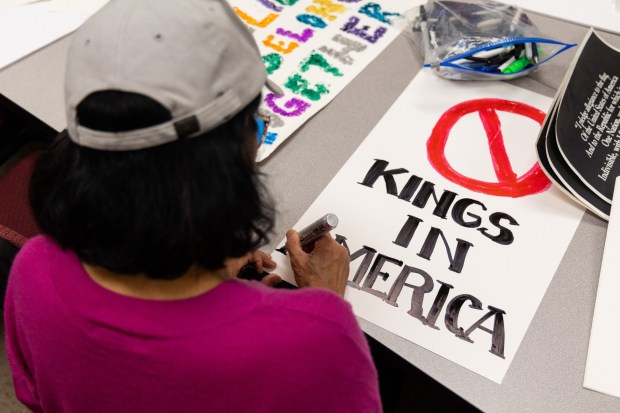 Cindy May, of Buffalo Grove, creates a protest sign Oct. 15, 2025, at the Japanese American Citizens League in Chicago’s Andersonville neighborhood, ahead of the No Kings protest. (Dominic Di Palermo/Chicago Tribune)
Cindy May, of Buffalo Grove, creates a protest sign Oct. 15, 2025, at the Japanese American Citizens League in Chicago’s Andersonville neighborhood, ahead of the No Kings protest. (Dominic Di Palermo/Chicago Tribune)
‘Making history’
Trump supporters have repeatedly disparaged the looming “No Kings” demonstrations, with Republican House Speaker Mike Johnson dubbing the worldwide event the “Hate America Rally.”
“Let’s see who shows up for that,” he said to reporters on Wednesday while discussing the government shutdown. “I bet you see pro-Hamas supporters. I bet you … see antifa-types. I bet you see the Marxists in full display. The people who don’t want to stand and defend the foundational truths of this republic.”
Event supporters say this characterization couldn’t be further from the truth.
Emily Cummings, event co-host for “No Kings Naperville,” said she views herself as fairly moderate politically.
“It’s not about the left or right. It’s about human rights issues,” she said. “I love Naperville. I love my state. I love my country. This, to me, is the way I can best show that. I think there’s a lot of people that feel that way and they’re showing up. They love democracy. So I think we’re going to see a record number of people coming out this weekend. We’re making history.”
Cummings said she’s seen recent fissures within the Republican Party and even some folks she knows who voted for Trump “are starting to realize this wasn’t what they expected.”
“People right, left and center are feeling this is wrong and are starting to stand up,” she said.
An Economist/YouGov poll released Tuesday found 40% of Americans strongly or somewhat approve of Trump’s leadership and 55% disapprove, up slightly from the previous week where 39% of Americans surveyed expressed support and 56% disapproved of his job performance.
In June, the “No Kings” protest in downtown Chicago was peaceful, as were most others across the country. Yet there were pockets of violence and tumult at or after demonstrations in other states.
At a Utah rally, a safety volunteer fired at an alleged gunman and inadvertently killed a protester. Police in Los Angeles used tear gas and crowd-control munitions to disperse demonstrators in the aftermath of the formal event. In Portland, Oregon, law enforcement fired tear gas and projectiles to clear a crowd that protested in front of a U.S. Immigration and Customs Enforcement building well into the evening.
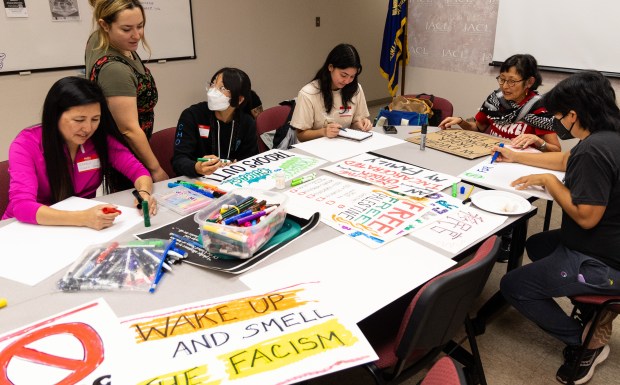 People create signs for the upcoming “No Kings” protest during a sign-making party Oct. 15, 2025, at the Japanese American Citizens League in Chicago’s Andersonville neighborhood. (Dominic Di Palermo/Chicago Tribune)
People create signs for the upcoming “No Kings” protest during a sign-making party Oct. 15, 2025, at the Japanese American Citizens League in Chicago’s Andersonville neighborhood. (Dominic Di Palermo/Chicago Tribune)
The national event is billed as a peaceful demonstration, with organizers barring protesters from bringing any weapons or illegal items.
The national American Civil Liberties Union hosted a one-hour “know your rights and de-escalation training” Wednesday, which was attended by thousands.
Tholin said the downtown Chicago protest is also committed to “peaceful, nonviolent protest.”
“Masses of people coming together to express their resistance to those actions is the fundamental characteristic of an American democracy. And peacefully. Coming together to peacefully express the protest against those actions,” she said. “The folks who are raging against peaceful democratic action are the ones who are un-American.”
Long-term change
Diana Hamann, owner of The Wine Goddess in Evanston, chartered a bus to take more than 50 people from the wine bar and retailer to the Grant Park demonstration on Saturday.
A sign in the window of her business reads, “Advice for ICE: 1. Quit job. 2. Get therapy.”
“My thought is I want to get as many people there as possible … But also to get people there together, in solidarity,” she said. “I think so many people feel completely helpless right now and are just absolutely heartbroken and torn apart about what’s going on under our noses every day.”
On a national level, one of the strengths of the “No Kings” movement is that the Trump administration provides a common target for many groups and populations, said David Meyer, professor of sociology at the University of California at Irvine.
Some might be against tariffs, some might be anti-corruption, and others could be outraged by immigration enforcement or health care and education cuts, said Meyer, co-editor of the book “The Resistance: The Dawn of the Anti-Trump Opposition Movement” and author of the book “How Social Movements (Sometimes) Matter.”
“There are a lot of people who have a lot of different gripes with the Trump administration. ‘No Kings’ has become a holder for all of them,” he said. “And they don’t necessarily agree with each other — the various constituencies that are involved — about everything.”
There’s been a trend in the last 10 or 15 years for protests to become more decentralized, Meyer said.
While demonstrations used to center in major cities, it’s become more common for many marches and rallies to spring up in suburbs or smaller cities across the country, as the “No Kings” events illustrate.
This can make it easier for participants to attend and organizers can also tailor demonstrations to more localized issues or concerns, he said.
But it can also make it harder to control the messages coming out of so many local events, in an era where one short video clip of an ignorant interview or photograph of an inappropriate sign can go viral, Meyer noted.
Protests can have a great impact on the individuals participating as well as broader policymaking, he said. Protesters can feel empowered, learn more and connect with community leaders, often spurring greater political involvement and future activism.
Politicians and leaders can also be swayed by large, peaceful demonstrations, Meyer added.
“If you’re an attorney general thinking about filing suit against the Trump administration and there’s a big turnout in the biggest city in your state, maybe it stiffens your spine a little bit and you feel a little bit stronger about doing it,” he said.
But even after successful protests, long-term change can be challenging, requiring continued work and advocacy afterward, Meyer said.
“Protest works but it doesn’t work by itself. It works in concert with a bunch of other political actions,” he said. “It’s hard to have this sense of perspective. In order to change the world, in order to bend the moral arc of history … the arc of justice in the right direction, you have to pull really hard.”
‘Entirely indefensible’
As for Ozaki, she said members of the Chicago chapter of the Japanese American Citizens League plan to join her in protest Saturday.
Like her family, some of the organization’s older members were incarcerated during the mass hysteria and xenophobia of World War II. Others had relatives who were also taken away during this period, which is now regarded as a deeply shameful moment in American history.
In August, the national Japanese American Citizens League put out a statement condemning an Immigration and Customs Enforcement detention center that opened at Fort Bliss, which was used as an incarceration camp for first-generation Japanese immigrants during World War II. The statement said that “whether it be 1942 or 2025, the mass incarceration and detention of immigrants based upon false narratives of ‘military necessity’ or ‘national security’ is entirely indefensible.”
“It hits home for a lot of us. Of course our liberation is all tied,” Ozaki said. “But for me and folks who have ancestors who were incarcerated during World War II, the way things are happening … feel so eerily similar to the stories I’ve heard from my grandparents.”
During the war, her grandfather, Sam Ozaki, was forcibly taken with the rest of his family to Santa Anita Park racetrack, where they were forced to live in tight, temporary quarters in the horse stalls.
“They treated the racehorses with a great deal of care because they were worth money,” Sam Ozaki had told the Tribune in 2011. “We were not worth two cents, because we had the face of the enemy.”
He and his family were later transferred to an incarceration center in Arkansas, where they were joined by his father.
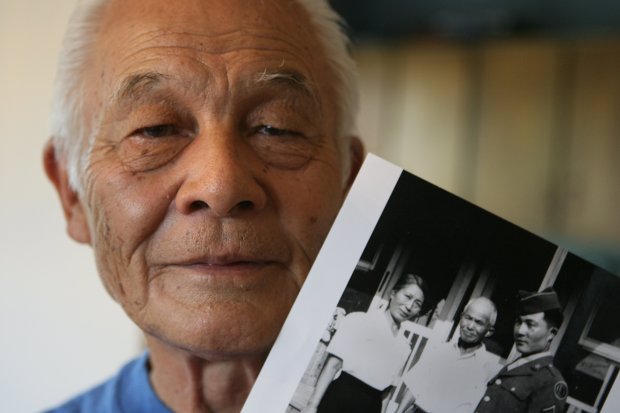 Rebecca Ozaki’s grandfather, Sam Ozaki, then 82, with a photo of himself as a U.S. soldier visiting his mom Tomino and dad Kyujiro in an internment camp during WWII as he talks about the camps at his Rogers Park home in 2007 in Chicago. He died at age of 90 in 2015. (Charles Osgood/Chicago Tribune)
Rebecca Ozaki’s grandfather, Sam Ozaki, then 82, with a photo of himself as a U.S. soldier visiting his mom Tomino and dad Kyujiro in an internment camp during WWII as he talks about the camps at his Rogers Park home in 2007 in Chicago. He died at age of 90 in 2015. (Charles Osgood/Chicago Tribune)
Despite this treatment, Sam Ozaki went on to fight in World War II for the country that wrongfully incarcerated him, serving in the segregated 442nd Regimental Combat Team, a unit of Japanese Americans.
He earned a Purple Heart and the 442nd Regimental Combat Team became one of the most decorated units in the history of the U.S. military.
Later, he took part in a national movement to get reparations for Japanese Americans who were incarcerated in camps after the bombing of Pearl Harbor. Republican President Ronald Reagan signed a law that issued a formal apology to survivors in 1988.
During Reagan’s remarks at the time, he noted that the 442nd Regimental Combat Team “served with immense distinction to defend this nation, their nation.”
“Yet back at home, the soldiers’ families were being denied the very freedom for which so many of the soldiers themselves were laying down their lives,” he said.
Sam Ozaki died at the age of 90 in 2015.
His granddaughter hopes to keep his story and spirit of advocacy alive through her own activism, including protesting at this weekend’s rally and march.
“We never want what happened to our community to happen again,” she said. “It’s important that we are the allies we wish we had back then.”
The Associated Press contributed.

